Paintings in Perpetuity
Oliver Stead, Curator of the Drawings, Paintings and Prints Collection, spoke at a campaign launch ‘Paintings in Perpetuity’ about the role of paintings in documenting our history as well as the challenges in conserving them.
Documenting the history of Oceania
The Drawings, Paintings and Prints Collection of the Alexander Turnbull Library is an incomparable research resource for the study of New Zealand and Pacific history. The collection has been built by the Library on the solid foundation of Alexander Turnbull’s own carefully selected but wide-ranging collection of pictures, comprising engravings, sketches and oil paintings.
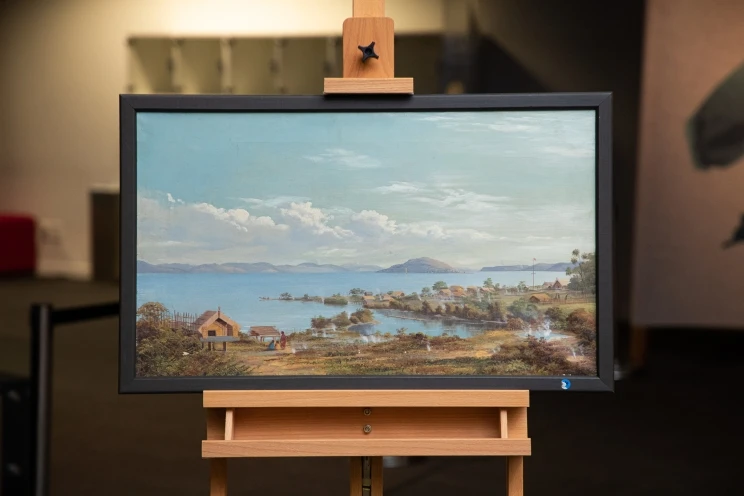
Charles Blomfield, ca. 1890. Showing Ohinemutu village in the foreground with steam vents rising amongst Māori dwellings. Lake Rotorua beyond and Mokoia Island rising in the distance with the far shore of Rotorua Lake beyond the island. Ref: G-459. Photo: Mark Beatty
While we value the drawings, paintings and prints as a terrifically useful research resource of pictures, documenting the history of Oceania from the time of earliest European contact, we are also constantly reminded that the collection includes many works of great artistry and visual appeal, representing iconic aspects of our part of the world. Alexander Turnbull himself, while consciously collecting artworks as evidence of history, is known from his letters to have held the purely aesthetic values of paintings in high regard.
Some of these works are very well known. They’ve been widely reproduced and are among the most familiar highlights of a collection from which published histories of New Zealand have drawn copious illustrations for decades. Television documentaries have also drawn heavily from the Turnbull’s collection of historical drawings and paintings, while digital content services, such as the DigitalNZ website produced by the National Library, feature many thousands of digitised images of original artworks connected to New Zealand and Pacific history, making these images accessible to all via the internet.
Digital imaging of art works
Though thousands of visual images in the Turnbull Library’s vast collection have been digitised and may be viewed online, many thousands more remain to be done, while the library continues to acquire important historical works though donation or purchase. Making large framed oil paintings accessible to all is challenging in all sorts of ways. While digital imaging of art works is tremendously helpful in enhancing access, it is by no means always straightforward to achieve.
For reasons of expediency, many of the digital images of Turnbull paintings available online have been scanned from old, deteriorated colour transparencies which do not show the works to their best advantage, obscuring information or showing damage all too clearly.
Some of the paintings in the Turnbull collection are very large and this makes moving them into position for new photography especially difficult. Others, especially those in the elaborate gilt plaster frames so popular in the Victorian era, are in such fragile condition that any movements risk further damage.
The original frames of some of the Library’s most valuable and iconic works have disintegrated altogether, or have been in such a poor state of repair that the Library has been forced to remove them for the safety of paintings and frames in storage.
Often the Library has needed to place eighteenth and nineteenth century masterpieces in temporary timber frames that are very out of character with the aesthetic intentions of the artist, and interfere with our ability to fully appreciate the artist’s skill and vision.
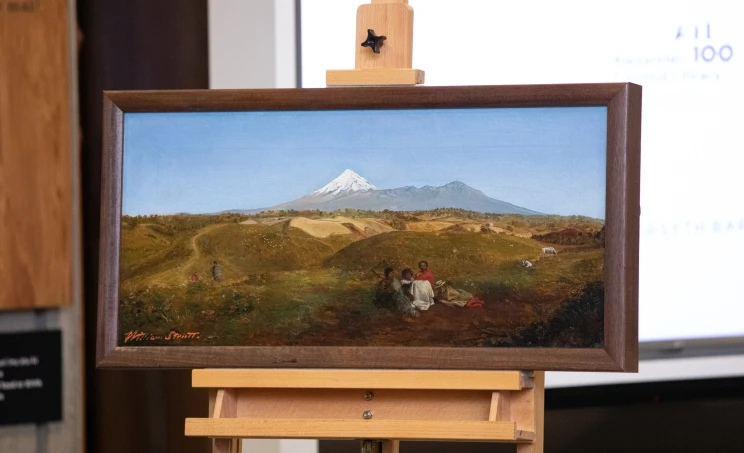
William Strutt's painting of Taranaki, 1856. Ref: G-695. Photo: Mark Beatty
The way a work of art is framed
As the art of painting is as much about the presentation of the visual information in a picture as the information itself, the way the work is framed has an important bearing on its subject. Sadly, many of the Turnbull Library’s important pictures are inappropriately or unattractively framed, diminishing the appeal of the work and our ability to interpret the information it can provide us about the context in which it was created.
In other cases the frame that the work was in when it arrived at the Turnbull was not original or suitable – for example when a painting has been forced or fitted incorrectly into a frame of the wrong size, covering up important information like signatures and inscriptions. Many of the paintings also need a thorough surface clean to remove decades or even centuries of accumulated dirt and grime.
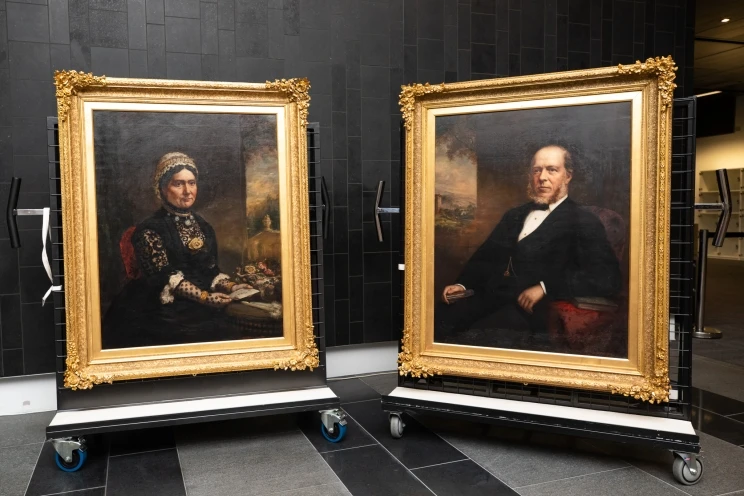
Alexander Turnbull's parents, Alexandrina and Walter. Ref: G-655, G-827-4-a. Photo: Mark Beatty
From cleaning, digitisation to framing and glazing
With these factors in mind it is easy to see that the conservation treatment of historical oil paintings is by nature multi-dimensional. As with other sorts of restoration work, ideally you want to do it once and do it well.
Each factor from cleaning to digitisation to framing and glazing needs to be considered in relation to the others and a careful logistical plan developed for treatment so the best, most effective solution can be obtained.
Yet what a revelation it is to see a neglected work magnificently restored to its former glory. Good paintings do reward care very amply. The Turnbull holds a few notable examples of this wonderful phenomenon. The twin portraits of Alexander Turnbull’s parents Alexandrina and Walter Turnbull are now spectacular, where before treatment they were in very poor shape indeed. Lovingly restored by master conservators Carolina Izzo and Detlef Klein, these portraits have been brought back to life and look splendid when exhibited in pride of place in the Katherine Mansfield Reading Room.
The corresponding portrait of Alexander’s sister Isabella however still languishes in the stores, inadequately framed and sadly lacerated with holes and abrasions in the canvas, unsuitable for exhibition.
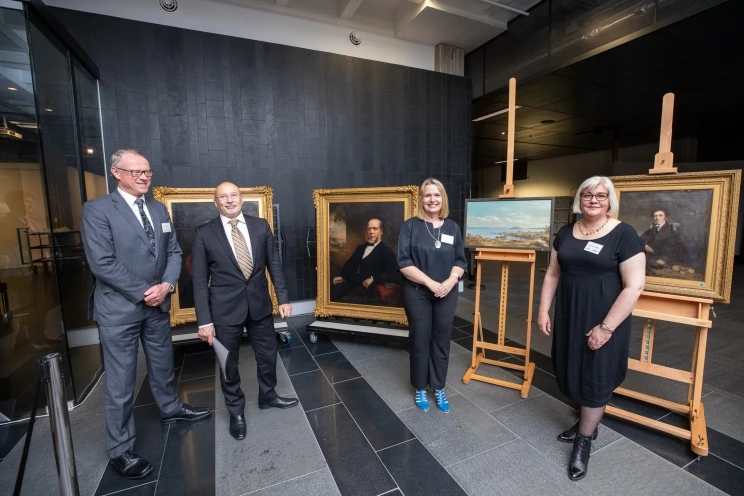
Pictured together are John Meads, Chair of the Trust, Chris Szekely, Chief Librarian of the Alexander Turnbull Library, Minister Hon Jan Tinetti and Barbara Blake, the inaugural donor of ‘Paintings in Perpetuity’. Photo: Mark Beatty
Lending art works for exhibition in other venues
As the Chief Librarian has noted, while the Library has limited resources for mounting exhibitions, it maintains a very active loans programme where art works are lent for exhibition in other venues. The Library’s policy with regard to loans of paintings is to require them to be glazed for their protection. Like many other aspects of treatment this is not always straightforward, as the glazing has to be precisely fitted to the frame, which as we have seen may not be suitable for the work itself or for glazing.
These days the technology of non-reflective glazing is highly sophisticated. Using products such as the Optium brand of non-reflective acrylic it is possible to eliminate almost all reflection from the surface of the glazing so that the work can be exhibited with appropriate lighting and still be seen without annoying interference from reflections – the glazing product is virtually invisible. This has only recently become possible through advances in manufacturing. But the material is expensive. Many of the Turnbull’s paintings have been glazed in the past with inferior materials which continue to spoil our view of the work through excessive reflection.
It would be wonderful to remedy these defects for such iconic paintings as the James Barry portrait on display tonight, of Hongi Hika, Waikato and Thomas Kendall on their historic visit to England in 1820. Also on display this evening are some examples of important paintings in need of one or other or all of the treatments I’ve described.
We look forward to being able to achieve this outcome for some of the nation’s most important works of art, with the continued valued support of the Alexander Turnbull Library Endowment Trust and our stakeholders, the people of New Zealand.
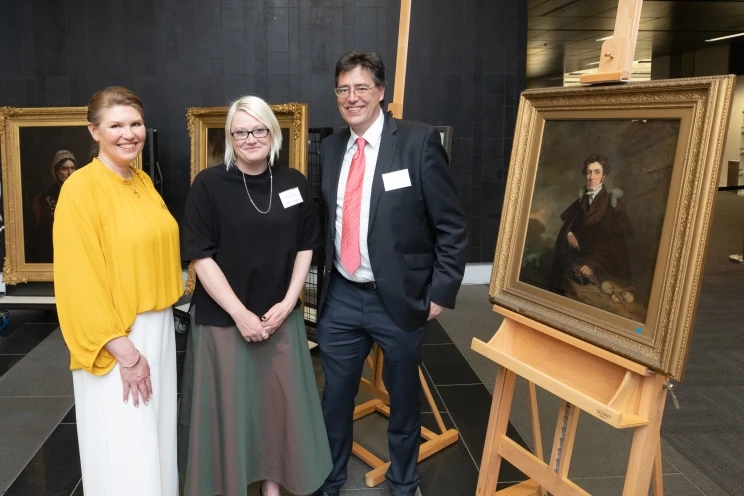
Paula Maclachlan, Executive Director of the Turnbull Endowment Trust with Jessica Gray, ATL 100 Programme Manager and Turnbull Library Curator, Oliver Stead, during the launch event for Paintings in Perpetuity. Photo: Mark Beatty
Paintings in Perpetuity
Paintings in Perpetuity is a fundraising campaign to repair and clean oil paintings that are held in the Alexander Turnbull Library collections. It was launched by the Turnbull Endowment Trust on Monday evening, 23 November, at the National Library in Wellington.
Paintings in Perpeutity — Find out more about the fundraising campaign on the Turnbull Endowment Trust website.
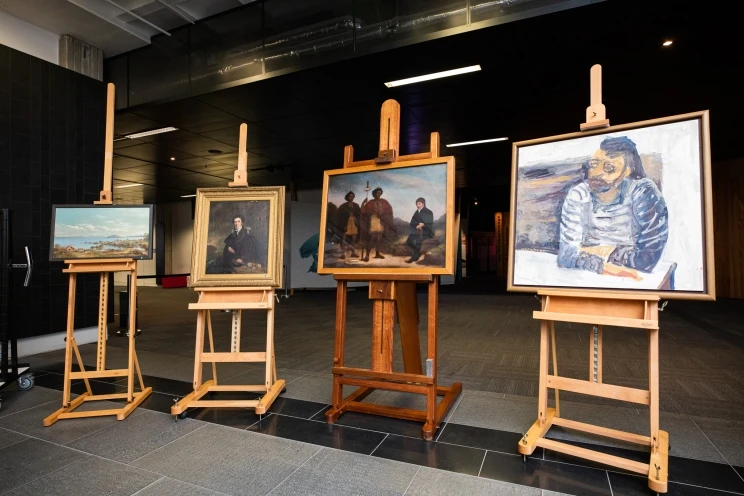
A fundraising campaign to repair and clean oil paintings was launched recently by the Turnbull Endowment Trust at the National Library. The campaign ‘Paintings in Perpetuity’ invites individuals, families and organisations to choose a painting and support its treatments financially. Some examples of the paintings that are being supported. Photo: Mark Beatty